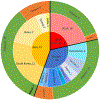3D printing restorative materials using a stereolithographic technique: a systematic review
- PMID: 33353734
- PMCID: PMC7855936
- DOI: 10.1016/j.dental.2020.11.030
3D printing restorative materials using a stereolithographic technique: a systematic review
Abstract
Objective: To present through a systematic review a qualitative analysis of studies published on stereolithography-based 3D printing of restorative materials and their clinical applicability.
Methods: The literature search was conducted based on the question: "What is the state-of-the-art of available restorative materials for 3D printing based on stereolithography?" Online search was conducted in three databases (MEDLINE/PubMed, Scopus and Web of Science) with no restriction for year of publication. Data are reported based on PRISMA, including publication details such as authors and their countries, year and journal of publication, and study design. The synthesis is focused on describing the dental restorative materials and properties evaluated, applied methods, 3D printers used and clinical applicability.
Results: Studies that fit the inclusion criteria were performed in Asia (21), Europe (16) and USA (10), mostly using polymer-based restorative materials (38) for 3D printing constructs. Stereolithographic-printed ceramic-based restorative structures were evaluated by 9 studies. Many studies reported on dimensional accuracy (14), strength (11) and surface morphology (9) of the printed structures. Antibacterial response, cytotoxicity, internal and marginal fit, fracture and wear resistance, density, viscosity, elastic modulus, hardness, structural shrinkage and reliability, degree of conversion, layer cure depth, fatigue, and color were also evaluated by the included studies. Many of them (11) published a proof of concept as an attempt to demonstrate the clinical feasibility and applicability of the technology to print restorative materials, but only 5 studies actually applied the 3D printed restorative structures in patients, which highlights an increasing interest but limited early-stage translation.
Significance: The fast expansion of stereolithographic-based 3D printing has been impressive and represents a great technological progress with significant disruptive potential. Dentistry has demonstrated an incredible willingness to adapt materials, methods and workflows to this promising digital technology. However, esthetic appearance, wear resistance, wet strength and dimensional accuracy are the main current clinical limitations restricting the progression to functional part production with 3D printing, which may explain the absence of clinical trials and reports on permanent/definitive dental restorative materials and structures.
Keywords: 3D printing; Dental materials; Dentistry.
Copyright © 2020 The Academy of Dental Materials. Published by Elsevier Inc. All rights reserved.
Figures
References
-
- van Noort R The future of dental devices is digital. Dent Mater 2012;28:3–12. - PubMed
-
- Alessandretti R, Borba M, Benetti P, Corazza PH, Ribeiro R, Della Bona A. Reliability and mode of failure of bonded monolithic and multilayer ceramics. Dent Mater 2017;33:191–7. - PubMed
-
- Alessandretti R, Borba M, Della Bona A. Cyclic contact fatigue resistance of ceramics for monolithic and multilayer dental restorations. Dent Mater 2020;36:535–41. - PubMed
-
- Basso GR, Moraes RR, Borba M, Duan Y, Griggs JA, Della Bona A. Reliability and failure behavior of CAD-on fixed partial dentures. Dent Mater 2016;32:624–30. - PubMed
-
- Colpani JT, Borba M, Della Bona A. Evaluation of marginal and internal fit of ceramic crown copings. Dent Mater 2013;29:174–80. - PubMed
Publication types
MeSH terms
Grants and funding
LinkOut - more resources
Full Text Sources
Other Literature Sources



